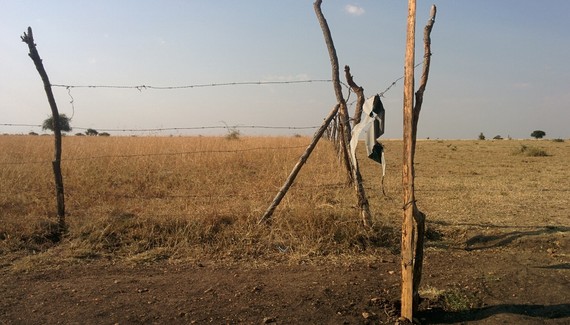It's easier and easier to understand the impacts a changing climate has on our daily lives: higher temperatures can affect everything from the food we eat, to the bills we pay for air conditioning in the summer and heat in the winter.

Fencing in Siana Conservancy, highlighting the difference in pasture between fenced and unfenced land.
But we're not the only ones affected. Climate change also impacts wildlife and the habitat on which they depend. Changes in climate are altering the timing of life cycles, causing species to shift where they live, and in some cases even leading to extinction.
While the direct correlation between a changing climate and wildlife is increasingly clear, to date there's been less focus on understanding how human responses to climate change also impact wildlife and their habitat. That's where my work comes in.
I recently visited the Siana conservancy in Kenya, part of the Greater Mara ecosystem. This part of the world, home to the Maasai people of Kenya, has one of the most spectacular concentrations of wildlife on the planet, including the famous "Big Five:" lions, leopards, rhinos, elephants and African buffalos. The Maasai people are pastoral, and they and their livestock have coexisted with wildlife for generations. However, successive seasons of failed or erratic rains, particularly during the long rainy season, have plunged much of the region into frequent periods of drought over the last few years.
During my visit, I met with community members and park rangers to understand how changing weather and climate over the last few years have impacted their daily lives. I wanted to find out what they are doing differently. How exactly are they responding to these changes?
In these conversations, I looked for hints of any novel responses that could be adopted elsewhere. And, I looked for examples of how their new "way of life" could be impacting the wildlife that also calls this area home.
I learned quickly that pasture is one of the most important resources in this area. The Maasai need it to feed the livestock that provides the foundation of local livelihoods. But, those large open plains also provide for millions of other grazing animals including wildebeest, zebras, and gazelles, particularly during the peak of the great animal migration across the Mara-Serengeti area - which is when I happened to visit.
In order to conserve pasture for their grazing livestock, the Maasai were erecting fences across large swaths of land, particularly during times of drought. Unfortunately, this fencing disrupts the migration of the native wildlife, and restricts their freedom to roam. This situation is further complicated by climate-driven weather events: rivers which used to flow year round are now seasonal, which is increasing competition for water between wildlife, humans and livestock.
However, there are solutions! During periods of drought, the Maasai are allowed to graze their livestock inside the protected conservancy in specified areas for certain amounts of time. They are investing in more productive livestock breeds and reducing the number of livestock they keep, particularly during lean times. And, communities are also harvesting rainwater, using the roofs of buildings to capture rain, then storing it in above and below ground water tanks for later use.
While this research is moving forward, we are beginning to share what we've learned with colleagues working in Africa and other parts of the world. At this week's IUCN World Conservation Congress, we're talking about these and other human responses to climate change, including the latest research in this emerging field. We're also talking about how WWF's new Climate Crowd initiative is crowdsourcing data to document human responses to climate change across the globe, and how others can use this data to develop interventions that help people and wildlife persist in a changing climate. It's exciting work and we're fortunate to work with incredible collaborators including IUCN, the Peace Corps and the USAID-funded Africa Biodiversity Collaborative Group.
Climate change is already taking a toll on us and also on the wildlife that share this world with us. And, climate change will continue to exacerbate existing threats -- like habitat destruction and overexploitation - for the world's already imperiled wildlife. We can -- we must -- help species adapt to our changing world by ensuring that our own responses to climate change factor in the health and wellbeing of the wildlife and the habitat they depend upon.
This post is part of a series on the World Conservation Congress taking place this week. Held every four years, it brings together about 6,000 people, including heads of state, government officials, business leaders, representatives from indigenous groups, scientists, academics, influencers, educators, artists and NGOs, from all over the world to discuss and decide on solutions to the world's most pressing environmental challenges. To read all the posts in this series click here.
